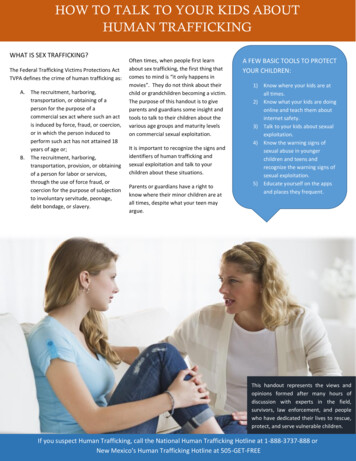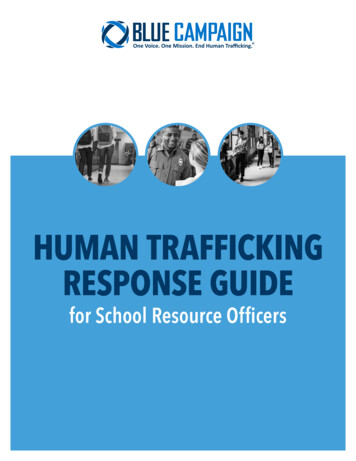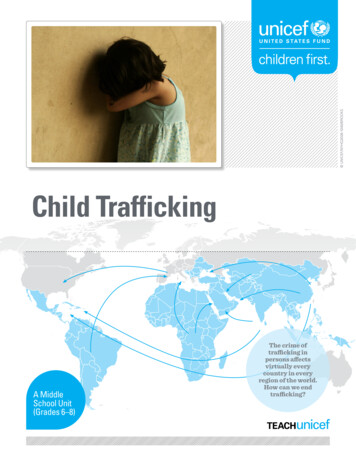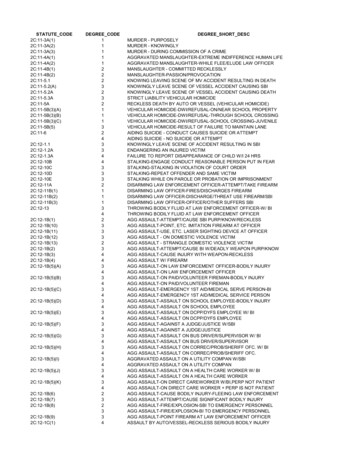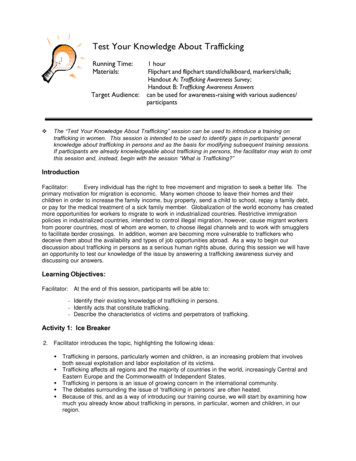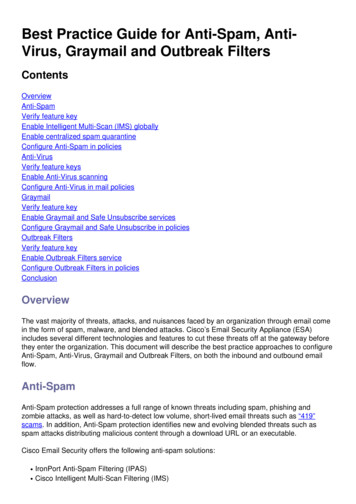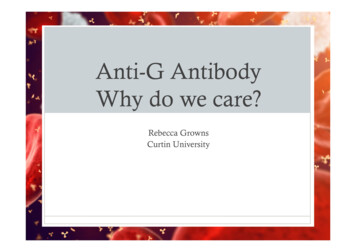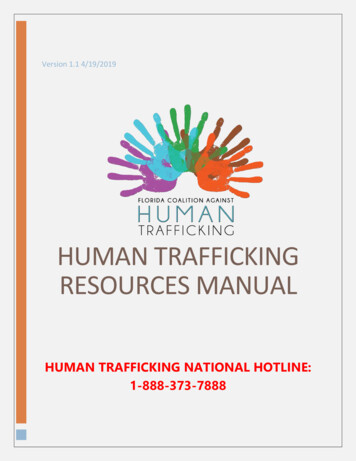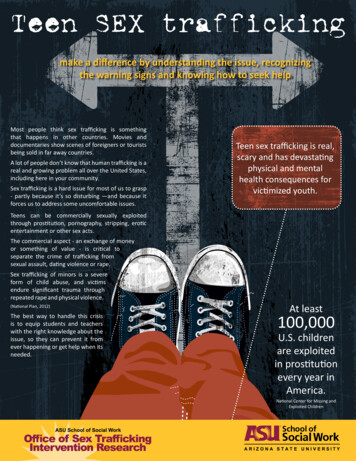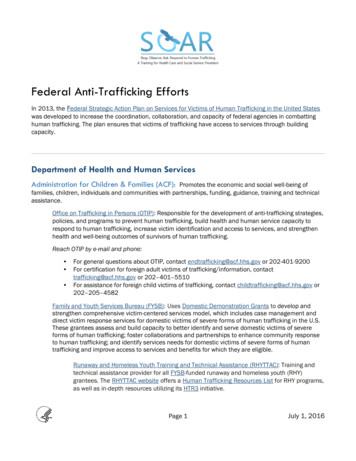
Transcription
Federal Anti-Trafficking EffortsIn 2013, the Federal Strategic Action Plan on Services for Victims of Human Trafficking in the United Stateswas developed to increase the coordination, collaboration, and capacity of federal agencies in combattinghuman trafficking. The plan ensures that victims of trafficking have access to services through buildingcapacity.Department of Health and Human ServicesAdministration for Children & Families (ACF):Promotes the economic and social well-being offamilies, children, individuals and communities with partnerships, funding, guidance, training and technicalassistance.Office on Trafficking in Persons (OTIP): Responsible for the development of anti-trafficking strategies,policies, and programs to prevent human trafficking, build health and human service capacity torespond to human trafficking, increase victim identification and access to services, and strengthenhealth and well-being outcomes of survivors of human trafficking.Reach OTIP by e-mail and phone: For general questions about OTIP, contact endtrafficking@acf.hhs.gov or 202-401-9200 For certification for foreign adult victims of trafficking/information, contacttrafficking@acf.hhs.gov or 202–401–5510 For assistance for foreign child victims of trafficking, contact childtrafficking@acf.hhs.gov or202–205–4582Family and Youth Services Bureau (FYSB): Uses Domestic Demonstration Grants to develop andstrengthen comprehensive victim-centered services model, which includes case management anddirect victim response services for domestic victims of severe forms of human trafficking in the U.S.These grantees assess and build capacity to better identify and serve domestic victims of severeforms of human trafficking; foster collaborations and partnerships to enhance community responseto human trafficking; and identify services needs for domestic victims of severe forms of humantrafficking and improve access to services and benefits for which they are eligible.Runaway and Homeless Youth Training and Technical Assistance (RHYTTAC): Training andtechnical assistance provider for all FYSB-funded runaway and homeless youth (RHY)grantees. The RHYTTAC website offers a Human Trafficking Resources List for RHY programs,as well as in-depth resources utilizing its HTR3 initiative.Page 1July 1, 2016
Domestic Violence Resource Network: Funded by the Family Violence Prevention & ServicesProgram. Examples of resources from the DVRN members: Article on trafficking Collection of webinars and trainings National Latino Network Webinar on Human Trafficking and the Experiences of Transgender Immigrant LatinoSurvivors Webinar on Seeing the Wendigo: Sex Trafficking Part 2 (American Indians and SexTrafficking) Webinar on Trauma-Informed Approaches for Supporting Domestic TraffickingSurvivors Webinar on Understanding Trafficking to Develop a Local Tribal ResponseChildren’s Bureau (CB): Focuses on improving the lives of children and families through programsthat reduce child abuse and neglect, increase the number of adoptions, and strengthen foster care.CB builds a broad overview of the crossover between the child welfare field and the work currentlybeing done to prevent and respond to human trafficking of children and youth in the United States.Child Information Welfare Gateway: Promotes the safety, permanency, and well-being ofchildren, youth, and families by connecting child welfare, adoption, and related professionalsas well as the public to information, resources, and tools covering topics on child welfare,child abuse and neglect, out-of-home care, adoption, and more. This site connects users toinformation and resources on a range of topics including human trafficking, and it suppliesweb-based information on all aspects of child welfare for professionals.Child Welfare Capacity Building Collaborative: Raises awareness and provides resources tosupport the implementation of the Preventing Sex Trafficking and Strengthening Families Act(P.L. 113-183) provisions. Signed into law on September 29, 2014, P.L. 113-183 amendsthe Title IV-E foster care program and presents new child welfare requirements on severalprovisions, including identifying, reporting, and determining appropriate services for child andyouth victims of sex trafficking and youth at risk; and implementing a reasonable andprudent parent standard (RPPS) for foster parents and child care providers to promotedevelopmentally appropriate activities and "normalcy" for children and youth in foster care.Centers for Disease Control (CDC): Works to protect America from health, safety and security threats,both foreign and in the U.S.Division of Violence Prevention: The CDC’s child maltreatment program is coordinated by the Divisionof Violence Prevention (DVP), within the National Center for Injury Prevention and Control (NCIPC).The mission of the division is to prevent violence-related injuries and deaths through surveillance,research and development, capacity building, communication and leadership. In pursuit of thatmission, CDC's efforts to prevent child maltreatment focus on developing, evaluating, anddisseminating evidence-based interventions that support safe, stable and nurturing relationships(SSNRs) for children.Health Resources Services Administration (HRSA): Works to improve health and achieve healthequity through access to quality services, a skilled health workforce and innovative programs. HRSA'sprograms provide health care to people who are geographically isolated, or economically or medicallyvulnerable.Page 2July 1, 2016
HRSA’s Office of Women’s Health: Coordinates women’s health-related activities across the HealthResources Services Administration (HRSA) to reduce sex and gender-based disparities and supportcomprehensive, culturally competent, and quality health care. In support of this mission,OWH integrates women's health policy and programming across HRSA bureaus and offices; supportseducational and informational dissemination efforts on topics related to women's health; encouragesand supports a transformed health care delivery system that increases access to high quality, costeffective health care, with particular focus on underserved women; and improves efficiency andeffectiveness of operation.Office of the Assistant Secretary of Health (OASH): Oversees 12 core public health offices —including the Office of the Surgeon General and the U.S. Public Health Service Commissioned Corps — aswell as 10 regional health offices and 10 presidential and secretarial advisory committees.Office on Women’s Health: Provides national leadership and coordination to improve the health ofwomen and girls through policy, education and model programs. Works to advance and coordinate acomprehensive women's health agenda throughout HHS to address health care prevention andservice delivery, research, public and health care professional education, and career advancementfor women in the health professions and in scientific careers. Collaborates with numerousgovernment agencies, non-profit organizations, consumer groups, and associations of health careprofessionals. Focuses on women's health priorities to meet the sweeping demographic trends of thenext century and to focus on the millions of underserved women in America.Substance Abuse and Mental Health Services Administration (SAMHSA): Funds services forindividuals who have or are at risk for mental and substance abuse disorders. State substance abuse andmental health agencies administer these programs. All decisions regarding eligibility for services and typesof treatment are made at the local and state levels, or by the provider.National Child Traumatic Stress Network (NCTSN): Works to raise the standard of care and improveaccess to services for traumatized children, their families and communities throughout the UnitedStates. NCTSN works to accomplish its mission of serving the nation's traumatized children and theirfamilies by: 1) Raising public awareness of the scope and serious impact of child traumatic stress onthe safety and healthy development of America's children and youth, and 2) Advancing a broad rangeof effective services and interventions by creating trauma-informed developmentally and culturallyappropriate programs that improve the standard of care.Department of Homeland SecurityImmigration and Customs Enforcement: The HSI Victim Assistance Program coordinates services tohelp human trafficking victims, such as crisis intervention, counseling, and emotional support. Contact theHSI Victim Assistance Program at 1–866–872–4973.United States Citizenship and Immigration Services (USCIS): Helps protect immigrant victims ofhuman trafficking and other crimes by providing immigration relief. For questions about VAWA, U visas, or Tvisas, contact USCIS by e-mail or phone: hotlinefollowupI918I914.vsc@dhs.gov or 802–527–4888.Page 3July 1, 2016
Department of JusticeOffice for Victims of Crime (OVC): Provides technical assistance to the Anti-Human Trafficking TaskForces, as well as victim services funding for foreign national victims of trafficking, and pilot sites for U.S.citizen minor victims of trafficking.Child Exploitation and Obscenity Section (CEOS): Prosecutes cases of child pornography, sextrafficking of children, parental child abduction, and sex tourism.Civil Rights Division: Human Trafficking Prosecution Unit (HTPU) consolidates the expertise of thenation’s top human trafficking prosecutors. HTPU prosecutors work with Assistant U.S. Attorneys and lawenforcement agents to streamline investigations, ensure consistent application of trafficking statutes, andidentify multijurisdictional trafficking networks. HTPU can provide victim assistance resources, legalguidance, and coordination between districts prosecuting overlapping criminal networks.Bureau of Justice Assistance (BJA): Anti-Human Trafficking Task Force Initiative funds collaborative lawenforcement and non-governmental partner task forces nationwide.Bureau of Justice Statistics (BJS): The Human Trafficking Reporting System (HTRS), in conjunctionwith Northeastern University, tracks and analyzes human trafficking crimes reported by the Anti-HumanTrafficking Task Forces.National Institute of Justice (NIJ): Funds research on human trafficking in the U.S. and around theworld.Office of Juvenile Justice and Delinquency Prevention (OJJDP): Internet Crimes Against ChildrenTask Forces (ICAC) investigates Internet-related crimes of child pornography and enticement, andimplements a number of training and capacity-building initiatives related to the commercial sexualexploitation of children (CSEC).Federal Bureau of Investigation (FBI): Office of Victim Assistance (OVA) is responsible for ensuringthat victims of crime are provided assistance to help them cope with the impact of the crime, as required byfederal law and the Attorney General Guidelines on Victim and Witness Assistance. Contact the OVA programmanagers by phone: 202–324–1339.Department of LaborBureau of International Labor Affairs (ILAB): Office of Child Labor, Forced Labor and HumanTrafficking publishes reports on international child labor, forced labor and human trafficking and providesfunding to combat international child labor.Wage and Hour Division (WHD): Enforces federal labor laws including the Fair Labor Standards Act(FLSA) and the Migrant and Seasonal Agricultural Workers Protection Act (AWPA) and assists with humantrafficking investigations involving the violation of these laws.Page 4July 1, 2016
Department of StateOffice to Monitor and Combat Trafficking in Persons (J/TIP):Conducts awareness-raisingactivities, diplomacy with other countries, and funding for international anti-trafficking initiatives. Publishesthe annual Trafficking in Persons Report, which rates countries on their anti-trafficking efforts. Maintainsa list of resources and information for individuals in the U.S. on a nonimmigrant work or travel visa.Human Smuggling and Trafficking Center: A collaborative effort between the Department of State,Department of Justice, Department of Homeland Security and the Office of the Director of NationalIntelligence, and functions as a centralized information center for smuggling, human trafficking and nationalsecurity.Equal Employment Opportunity Commission (EEOC)Enforces federal laws that make it illegal to discriminate against a job applicant or an employee because ofthe person's race, color, religion, sex (including pregnancy), national origin, age (40 or older), disability orgenetic information.Department of EducationProvides resources for educators and administrators on combatting trafficking through school systems.Offers a Human Trafficking in America’s Schools resource and protocol (navigate guide online or downloadcomplete version at the website).Department of Housing and Urban DevelopmentProvides relevant links to laws, issue briefs, research, and other tools to assist homeless service providers incombating human trafficking.For additional Federal agencies, visit ndex.htm.Page 5July 1, 2016
federal law and the Attorney General Guidelines on Victim and Witness Assistance. Contact the OVA program managers by phone: 202-324-1339. Department of Labor . Bureau of International Labor Affairs (ILAB): Trafficking publishes reports on international child labor, forced labor and human trafficking and provides

